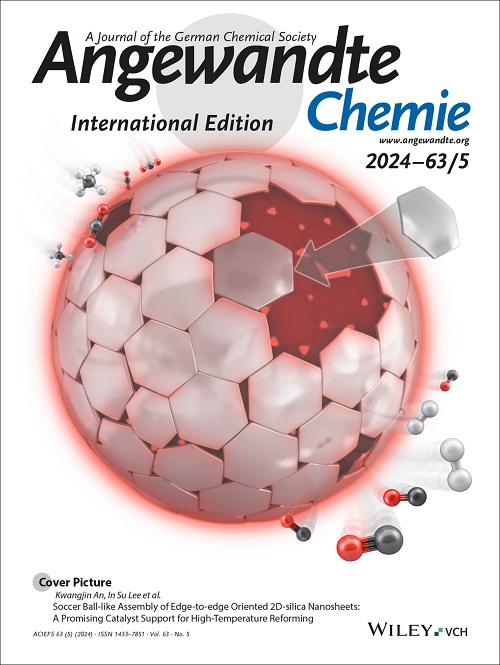Heterogeneous Carbonylation of Alcohols on Charge-Density-Distinct Mo-Ni Dual Sites Localized at Edge Sulfur Vacancies
IF 16.1
1区 化学
Q1 CHEMISTRY, MULTIDISCIPLINARY
引用次数: 0
Abstract
Alcohols carbonylation is of great importance in industry but remains a challenge to abandon the usage of the halide additives and noble metals. Here we report the realization of direct alcohols heterogeneous carbonylation to carbonyl-containing chemicals, especially in methanol carbonylation, with a remarkable space-time-yield (STY) of 4.74 molacetyl/kgcat./h and a durable stability as long as 100 h on Ni@MoS2 catalyst. Mechanistic analysis reveals that the Mo-Ni dual sites localized at edge sulfur vacancies of Ni@MoS2 exhibit distinct charge density, which strongly activate CH3OH to break its C-O bond and non-dissociatively activate CO. Density functional theory calculations further suggest that the low charge density in Mo-Ni, the Ni site, could significantly lower the barrier for CO migration and nucleophilic attack of methoxy species, and finally leads to the rapid formation of acetyl products. Ni@MoS2 catalyst could also effectively realize the carbonylation of ethanol, n-propanol and n-butanol to their acyl products, which may demonstrate its universal application for alcohols carbonylation.边缘硫空位上电荷密度不同的钼镍双位上的醇异相羰基化反应
醇类羰基化在工业中具有重要意义,但放弃使用卤化物添加剂和贵金属仍是一项挑战。在此,我们报告了在 Ni@MoS2 催化剂上实现直接醇异相羰基化到含羰基化学品的过程,尤其是甲醇羰基化,其空间-时间-产量(STY)达到 4.74 molacetyl/kgcat./h,且持久稳定性长达 100 h。机理分析表明,定位于 Ni@MoS2 边缘硫空位的 Mo-Ni 双位点表现出独特的电荷密度,可强烈激活 CH3OH,使其断裂 C-O 键,并以非解离方式激活 CO。密度泛函理论计算进一步表明,Mo-Ni(即 Ni 位点)的低电荷密度可显著降低 CO 迁移和甲氧基亲核攻击的障碍,并最终导致乙酰产物的快速形成。Ni@MoS2 催化剂还能有效地实现乙醇、正丙醇和正丁醇羰基化成其酰基产物,这可能证明了其在醇羰基化方面的普遍应用。
本文章由计算机程序翻译,如有差异,请以英文原文为准。
求助全文
约1分钟内获得全文
求助全文
来源期刊
CiteScore
26.60
自引率
6.60%
发文量
3549
审稿时长
1.5 months
期刊介绍:
Angewandte Chemie, a journal of the German Chemical Society (GDCh), maintains a leading position among scholarly journals in general chemistry with an impressive Impact Factor of 16.6 (2022 Journal Citation Reports, Clarivate, 2023). Published weekly in a reader-friendly format, it features new articles almost every day. Established in 1887, Angewandte Chemie is a prominent chemistry journal, offering a dynamic blend of Review-type articles, Highlights, Communications, and Research Articles on a weekly basis, making it unique in the field.

 求助内容:
求助内容: 应助结果提醒方式:
应助结果提醒方式:


